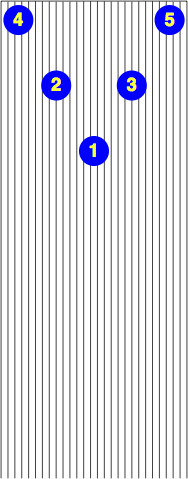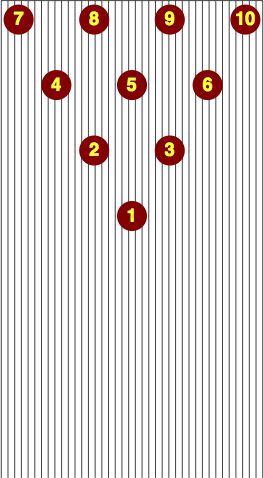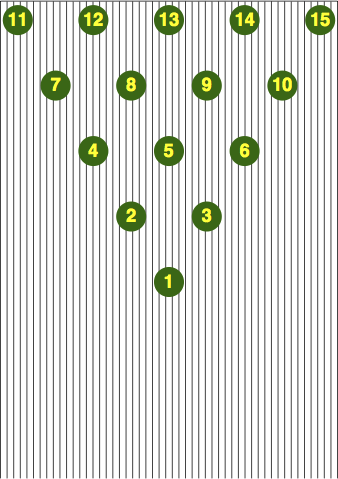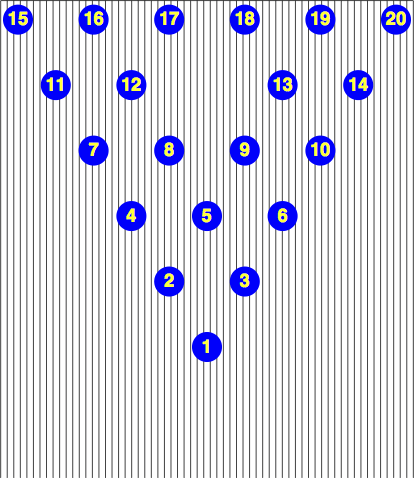
5 pins are arranged in a vee, at a center-to-center distance of 12 inches, their positions numbered for reference.
The lane, 29½ inches wide, would be constructed of 27 boards each slightly more than one inch wide. The length of the lane is as desired.

10 pins are arranged in a triangle, at a center-to-center distance of 12 inches, their positions numbered for reference.
The lane, 41½ inches wide, is traditionally constructed of 39 boards each slightly more than one inch wide. The length of the lane is 60 feet from foul line to the center of the number-1 pin.

15 pins are arranged in a triangle, at a center-to-center distance of 12 inches, their positions numbered for reference.
The lane, 53½ inches wide, would be constructed of 51 boards each slightly more than one inch wide. The length of the lane is as desired.

20 pins are arranged in a triangle with one gap, at a center-to-center distance of 12 inches, their positions numbered for reference.
The lane, 65½ inches wide, would be constructed of 63 boards each slightly more than one inch wide. The length of the lane is as desired.
- The frame ends.
- Earned are 5 points plus a bonus equal to the pinfall of the next roll, which will occur in the next frame.
- The frame ends.
- Earned are 10 points plus a bonus equal to the combined pinfall of the next 2 rolls, which will occur in the next 1 or 2 frames.
- The frame ends.
- Earned are 15 points plus a bonus equal to the combined pinfall of the next 3 rolls, which will occur in the next 1, 2, or 3 frames.
- The frame ends.
- Earned are 20 points plus a bonus equal to the combined pinfall of the next 4 rolls, which will occur in the next 1, 2, 3, or 4 frames.
- The frame ends.
- Earned is 1 point for each pin felled, with no bonus.
- The frame ends.
- Earned are 10 points plus a bonus equal to the pinfall of the next roll, which will occur in the next frame.
- The frame ends.
- Earned are 15 points plus a bonus equal to the pinfall of the next 2 rolls, which will occur in the next 1 or 2 frames.
- The frame ends.
- Earned are 20 points plus a bonus equal to the pinfall of the next 3 rolls, which will occur in the next 1, 2 or 3 frames.
- The frame ends.
- Earned is 1 point for each pin felled, with no bonus.
- The frame ends.
- Earned are 15 points plus a bonus equal to the pinfall of the next roll, which will occur in the next frame.
- The frame ends.
- Earned are 20 points plus a bonus equal to the pinfall of the next 2 rolls, which will occur in the next 1 or 2 frames.
- The frame ends.
- Earned is 1 point for each pin felled, with no bonus.
- The frame ends.
- Earned are 20 points plus a bonus equal to the pinfall of the next roll, which will occur in the next frame.
- The frame ends.
- Earned is 1 point for each pin felled, with no bonus.
- If no pins are felled on the 1st roll, but all 10 on the 2nd roll, it counts as only a spare.
- If no pins are felled on the 1st roll, but all 15 on the 2nd roll, it counts as only a strike.
- If no pins are felled on the 1st and 2nd rolls, but all 15 on the 3rd roll, it counts as only a spare.
- If no pins are felled on the 1st roll, but all 20 on the 2nd roll, it counts as only a star.
- If no pins are felled on the 1st and 2nd rolls, but all 20 on the 3rd roll, it counts as only a strike.
- If no pins are felled on the 1st, 2nd, and 3rd rolls, but all 20 on the 4th roll, it counts as only a spare.
If all 5 pins are felled on the 1st roll, it is a spare, and the bowler gets 1 addtional roll.
… otherwise …
It is an open frame, and the bowler does not get a 2nd roll.
If all 10 pins are felled on the 1st roll, it is a strike, and the bowler gets 2 addtional rolls.
… otherwise …
If all remaining pins are felled on the 2nd roll, it is a spare, and the bowler gets 1 addtional roll.
… otherwise …
It is an open frame, and the bowler does not get a 3rd roll.
If all 15 pins are felled on the 1st roll, it is a star, and the bowler gets 3 addtional rolls.
… otherwise …
If all remaining pins are felled on the 2nd roll, it is a strike, and the bowler gets 2 addtional rolls.
… otherwise …
If all remaining pins are felled on the 3rd roll, it is a spare, and the bowler gets 1 addtional roll.
… otherwise …
It is an open frame, and the bowler does not get a 4th roll.
If all 20 pins are felled on the 1st roll, it is a diamond, and the bowler gets 4 addtional rolls.
… otherwise …
If all remaining pins are felled on the 2nd roll, it is a star, and the bowler gets 3 addtional rolls.
… otherwise …
If all remaining pins are felled on the 3rd roll, it is a strike, and the bowler gets 2 addtional rolls.
… otherwise …
If all remaining pins are felled on the 4th roll, it is a spare, and the bowler gets 1 addtional roll.
… otherwise …
It is an open frame, and the bowler does not get a 5th roll.
As before, felling all of them on the 1st try counts as a spare.
As before, felling all of them on the 1st try counts as a strike, and in 2 tries (if 2 rolls remain) a spare.
As before, felling all of them on the 1st try counts as an star, on 2 tries (if 2 rolls remain) a strike, and on 3 tries (if 3 rolls remain) a spare.
As before, felling all of them on the 1st try counts as a diamond, on 2 tries (if 2 rolls remain) a star, and on 3 tries (if 3 rolls remain) a strike, and on 4 tries (if 4 tries remain) is a spare.
Still, pins felled in the 5th frame can fulfill a bonus earned in the 4th frames
Still, pins felled in the 10th frame can fulfill bonuses earned in the 8th and 9th frames.
Still, pins felled in the 15th frame can fulfill bonuses earned in the 12th, 13th and 14th frames.
Still, pins felled in the 20th frame can fulfill bonuses earned in the 16th, 17th, 18th and 19th frames.
- 2 spares
- 3 strikes
- 2 strikes
- 1 strike and 1 spare
- 2, 3, or 4 stars
- 1 star and 1 strike
- 2 strikes
- 2, 3, 4, or 5 diamonds
- 2 or 3 stars
- 1 star and 1 spare
- 1 diamond and 2 stars
Notes.
As before, marks are denoted by special symbols with the number of strokes equalling the number of bonus rolls:
 spare
spare
 strike
strike
 star
star
 diamond
diamond
The numbers work out most elegantly in the 10-pin and 15-pin versions, and that is why they got treated on the main page. As for the 5-pin and 20-pin versions, some players may choose to fill the gap in the triangular arrangement of the pins, obtaining perhaps:
- a 6-pin game with 6 frames and a perfect score of 72 = 6 × 12.
- a 21-pin game with 21 frames and a perfect score of 2205 = 21 × 105.
The 5-pin game described here resembles traditional five-pin bowling in that the pins are arranged in a vee shape. However, in that game the lane is 41½ inches wide and the pins are 17 to 18 inches apart.